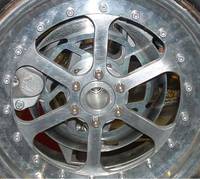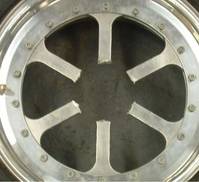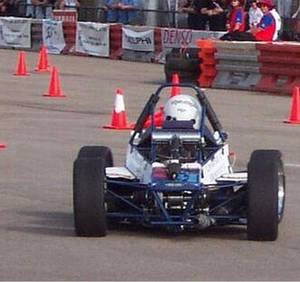Hello everyone. It is time to start planning for the next FSG competition, and so welcome to my first column for 2007.
Firstly, I would like to offer everyone all the best wishes for a successful and happy new year.
I will start this first column for 2007 with a few general notes and comments from the last year. In 2006, I attended three Student Design Formula events, Formula Student, Formula Student Germany and Formula SAE Australasia. How would I rate them? Well, I think FSG was the best, especially considering it was the first. Along with FSAE-A, there was a great camaraderie between the students and teams. This was exemplified by the assistance given to MADI by Oxford Brookes and others, and the spontaneous applause from all teams when the beleaguered team from Moscow finally made it to the track.
FSAEA has that happy Australian atmosphere and the extra driving given to teams gives teams the opportunity to come back from a failure that would have finished their effort in any other competition. This relieves the pressure slightly and so I think teams have more fun.
FStudent is an odd competition. There are some barriers in the UK educational system that somehow prevents teams from performing at their peak ability. It must be galling for the UK teams to have visitors come every year and take away their championship. This, along with some very officious judging parameters makes the event less fun for the participants. The location at Bruntingthorpe didn’t help, something that hopefully will be improved by the move to Silverstone.
And congratulations to University of Toronto, TU Graz and RMIT on winning those competitions I attended.
Each new year brings teams from new countries, this year they included teams from Malaysia and Russia among others. And each new year brings questions from teams regarding the competition.
We are constantly asked about changing the Formula to provide a so-called ‘level playing field’. What this really means is that some teams seem to continually top the result sheets (Lets call them the ‘A Teams’) and there is an opinion that a change of formula will let the others catch up.
At this point, I am of two minds about these suggestions. On the one hand, we are seeing more and more ‘legacy’ cars which are almost indistinguishable from their predecessors. On the other hand, so many teams fail to finish the project or complete all the dynamic tests that it is clear that many teams have not come to grips with the current regulations.
What happens with ‘Legacy’ cars in judging is the team members get quizzed hard about their understanding of why design decisions were made. Many teams fail to do this successfully (because the students who designed many facets of the car have long ago graduated and are no longer part of the team). This is why some seemingly great cars, or cars that perform well in the dynamic events, fail to score well in design. Then the judges hear comments that they don’t know what they are talking about. This is the main reason that the Design and Dynamic events must be kept separate as far as scoring is concerned.
Another question raised is the possibility of introducing a different engine formula, particularly diesel engines.
The prime intent of the competition is not to push the boundary of research, but rather to finish off the education of young engineers and other students associated with the competition.
If some product development can also come from it, then that is a bonus, but it is not the prime intent.
Diesel engines cause a series of problems for potential competitors.
Firstly, there is no real source of suitable engines for the competition.
Secondly, introduction of diesels would cause a whole raft of logistical and equality problems.
Finally, and this is very important. Diesel engines do not control engine output by throttling the air intake to the engine. Rather, they control the fuel injected. Modern diesels, that do have some throttle as part of their emission controls, have a ‘reactive’ throttle that controls airflow after the fueling calculation is done by the ECU. This throttle will also snuff out a runaway engine, but is electronically controlled by the ECU, something that is specifically banned by FSAE rules.
Diesel engines will runaway controllably if there is a lubricant or fuel leak into the intake tract. Broken piston rings or failed turbocharger seals can cause a diesel to run at almost full power with no input from the driver. This is a situation the safety officials will not permit to occur at this time. Let’s leave diesels and hybrids aside for the time being and concentrate on Otto cycle engines fuelled by petroleum or bio fuels.
There is a separate division in some competitions for hybrid drive cars if any team is interested, but at this stage, FSG is for cars built to meet the FSAE formula rules.
Increasingly, we are getting submissions from teams asking ‘Will this be okay at the competition’ ?. Teams should know that we are not going to prejudge your design. That is part of your task. If you are having any doubt, then submit a Safety Equivalancy form. You will probably find as you prepare this document that it becomes very obvious very quickly whether your design is suitable or not.
We cannot have a situation where students tell Tech Inspectors or Design Judges that ‘Pat told me to do it that way’. Pat only offers advice, not instructions on how to build your car. However, if we see a real problem, we will point it out so it can be rectified.
This months Design Error
More teams are making their own wheels. Usually they make or buy rims and then design and make an aluminium centre.
This seems a pretty straightforward task, yet many teams obviously do not understand the loads applied to a wheel on a racecar.
The shear loads across the interface between hub face and wheel is sometimes passed through the root of a thread on the wheel studs. This is particularly common where teams use high tensile bolts or Allen screws as wheel studs.
The wheel should be centered on a spigot on the hub face. Some teams assume that using conical nuts will centre the wheel for them. Conical nuts will introduce stresses in a light alloy wheel centre that may well cause a total failure of the wheel. This is a very public way to have a DNF and might well cause someone to get hurt. People have been injured by wheels coming off cars in competition.


Wheels before and after failure
All the best suspension calculations are useless if wheel flex permits the tyre to assume a positive camber attitude on the track under cornering loads.
This picture shows the effect of wheel flex on tyre camber.
So, until next month, good luck with your car and team building exercises.
Don’t be nervous!
Regards

Pat


